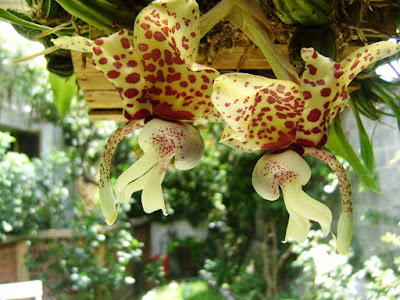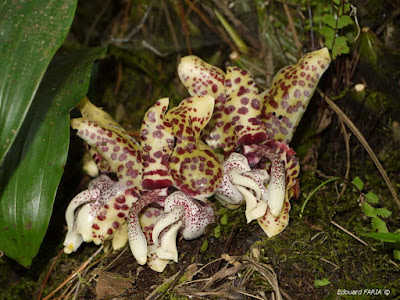Stanhopea hernandezii is native to Mexico and Guatemala. In Guatemala, these plants grew epiphytically in trees and rocks in forests at altitudes up to 1900 m. In Mexico, these plants were found in the states of Veracruz, Hidalgo, Puebla, Morelos, Michoacan, Oxaca and Chiapas...
Stanhopea hernandezii also called as Hernandez' Stanhopea, Anguloa hernandezii, Stanhopea cavendishii, Stanhopea devoniana, Stanhopea devoniensis, Stanhopea expansa, Stanhopea lyncea, is a species of the genus Stanhopea. This species was described by Rudolf Schlechter in 1918.
IDENTIFY STANHOPEA HERNANDEZII
Stanhopea hernandezii is native to Mexico and Guatemala. In Guatemala, these plants grew epiphytically in trees and rocks in forests at altitudes up to 1900 m. In Mexico, these plants were found in the states of Veracruz, Hidalgo, Puebla, Morelos, Michoacan, Oxaca and Chiapas.
It is a medium to large sized, warm to cool growing occasional epiphyte, terrestrial or lithophyte, which reaching 51 cm in height, with obliquely ovoid-conical, 6.4 cm long and 3.2 cm wide pseudobulbs enveloped basally by scarious sheaths and carrying a single, apical, oblong to elliptic-lanceolate, acuminate, shortly petiolate, plicate, 46 cm long leaves.
Hernandez' Stanhopea has large fragrant, waxy flowers on a pendulous, stout, 2 to 3 flowered inflorescence with several papery, spotted sheathing bracts occurring in the spring and summer. The flowers are up to 20 cm in diameter. The petals of both whorls, with pale yellow to yellowish-orange colors have reddish-brown spots of variable size. A huge, very fleshy, ivory-white lip has purple spots. The backbone is also white and has scarlet spots.
STANHOPEA HERNANDEZII CARE AND CULTURE
Cultural information should only be used as a guide, and should be to be adapted to suit you. Your physical location; where you grow your plants, how much time you have to devote to their care, and many other factors, will need to be taken into account. Only then can you decide on the cultural methods that best suit you and your plants.
Light:
Stanhopea hernandezii needs a light level of 25000-30000 lux. The light should be slightly filtered or scattered, and the plants should not be exposed to direct sunlight. Strong air movement should be ensured all the time.
Temperature:
The average temperature of the summer day is 26-27 ° C, night 14-15 ° C, and the daily difference is 12-13 ° C. In spring, the average day temperature is 28-30 ° C, the night 11-14 ° C, and the daily difference in this period decreases from 17 to 15 ° C. The average temperature of the winter day is 24-26 ° C, the night 7-9 ° C, and the daily difference is 16-17 ° C.
Humidity:
In the summer and early autumn, Hernandez' Stanhopea need the humidity of 70-75% and gradually decreases to 55-60% at the end of the dry season, which falls at the end of winter and spring.
Substrate, growing media and repotting:
The drooping inflorescences grow from the bases of pseudobulbs and therefore it is probably best to cultivate Stanhopea hernandezii mounted closely to the patches of tree ferns. Such cultivation requires, however, maintaining high humidity, and in the summer of daily watering. In the case of such suspended plants, during the dry and hot periods it may be necessary to water several times a day.
They are also grown in wire baskets with large mesh moss-covered with sphagnum moss and filled with loose, fast-drying soil. The substrate should remain moist, but it can not be wet, because the roots must dry relatively quickly after waterings.
Repotting or dividing a plant should only be done when the growth of new roots begins. This allows the plants to acclimatize in a relatively short time and provides them with the least stress.
Watering:
Precipitation is moderate to heavy from late spring through to autumn. Their quantity then decreases quite quickly and a 5-6 month dry season follows, lasting from late autumn until the beginning of spring. The cultivated plants should often be watered during active growth, but their roots must dry out between watering. In the autumn, after the flowering, the amount of water should be significantly reduced.
Fertilizer:
It is recommended to apply a 1/4-1/2 dose of orchid fertilizer weekly. You can use sustainable fertilizer throughout the year, but also can use high nitrogen fertilizer from spring to mid-summer, and then until the end of autumn high phosphorus fertilizer.
Rest period:
In winter, the amount of water to Stanhopea hernandezii should be limited , but they can not be too dry or dry for too long. Fertilization should be reduced or eliminated until new growths appear in the spring and the start of more abundant waterings.















COMMENTS